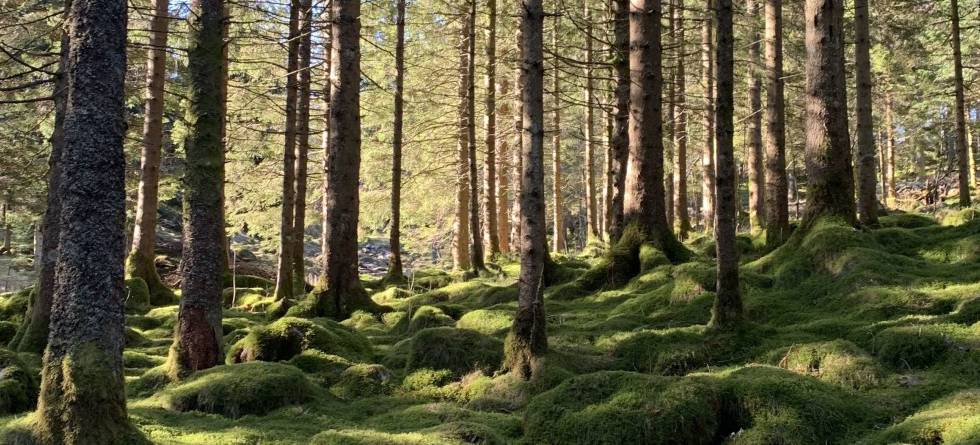Written by Hanna Lee, researcher at the Bjerknes Centre and NORCE
There’s something a lot of people don’t know about soil.
When it comes to carbon storage, soils store much more carbon than vegetation such as trees. If you knew this already, you already have an advanced knowledge about global carbon storage! Carbon storage in soils is not just a little more than vegetation. Globally, soils store 3-4 times more carbon than vegetation.
When plants shed leaves or die, this litter goes over the leaching process, and gets integrated as part of soil. This is called soil organic matter. When you look at soil, something that looks brown is likely soil organic matter. Soil organic matter gets decomposed by microorganisms, so soil organic matter is not a ‘permanent’ carbon storage, but this process takes a very long time. Some soil organic matter can even be thousands of years old. So we consider soil carbon a relatively stable storage of carbon.
Because soil organic matter decomposition is a biological process, wherever the environmental condition is favorable, the process will be faster. For instance, in the tropics, plants grow faster and shed a lot of leaves, but because microbial decomposition is also very fast, there is relatively small amount of carbon stored in soil. On the other hand, northern ecosystems tend to store large amounts of soil carbon.
In northern ecosystems, plants don’t grow as fast as in the tropics, but microbial decomposition is also very slow. This results in accumulation of soil carbon. Furthermore, when the soil is very wet, the environmental condition is highly unfavorable for microbial decomposition.
Think of those blanket bogs and mires. You might have thought of them as such useless land only filled with brown mud and mosquitoes. But these wetlands are a very large carbon storage because lack of oxygen under water slows down decomposition, allowing the soil to store a lot of carbon.
What does soil have to do with tree planting?
The argument most often used to support ‘plant trees to mitigate climate’ is that trees will take up more CO2 from the atmosphere and store it in the biomass. This is true. But something they often forget is the soil and its vast ability to store carbon and the amount of carbon already stored there.
Perhaps the complexity in the balance between increased vegetation production and soil organic matter decomposition is difficult to quantify. It is not as simple as ‘planting trees will increase CO2 uptake’. When we think about carbon gain from tree planting, we have to think about the ‘net’ carbon gain. If the carbon storage in both trees and in soil increases after planting trees, the net gain will be positive. But if the carbon storage in soil decreases more than carbon uptake by trees, the net gain will be negative.
In some cases, planting trees will increase soil carbon storage. Tree planting leads to increased vegetation production, which leads to increased litterfall and this leads to more soil carbon accumulation. This kind of results have been shown in Norway, particularly when the soil is sandy and dry, where initial soil carbon storage is not very large. In this case, the net carbon gain by tree planting will be positive. A recent government report supports this idea (Søgaard et al. 2019).
But if trees are planted where soil carbon storage is already large, the act of planting trees can cause disturbance, and disturbance accelerates decomposition. We may lose more carbon from the soil in this case. Particularly, if the tree planting involves draining of wet soil that has very large carbon storage, the loss of soil carbon will be immense.
A recent observational study supports this idea (Friggens et al. 2020). Even after 12–39 years of tree planting and carbon uptake by trees, it did not result in ‘net’ carbon accumulation. Although trees accumulated a lot of carbon during this time, the initial loss of soil carbon was too high to make up for it in this case.
So when someone asks me ‘Doesn’t tree planting in Norway increase carbon storage?’, I can only answer ‘It depends on where the trees are planted.’
We have to remember this. If we make wrong choices, like draining mires or bogs to plant trees, we may end up losing more carbon by planting trees. Because the loss of soil carbon may be much larger than the uptake of carbon by trees. And once the damage is done, it may not be reversible.
References
Friggens N.L. et al. 2020 Tree planting in organic soils does not result in net carbon sequestration on decadal timescales, Global Change Biology, 26:5178-5188.
Søgaard G. et al. 2019 Effekter av planting av skog på nye arealer: Betydning for klima, miljø og næring, NIBIO Raport 5(3).

